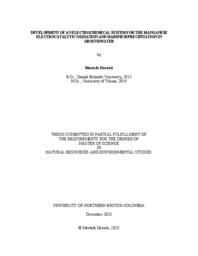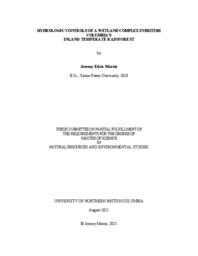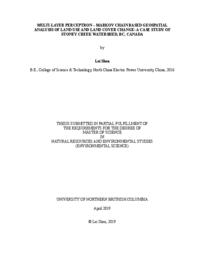Yin, Jun
Person Preferred Name
Jun Yin
Related Works
Content type
Digital Document
Description / Synopsis
Manganese is one of the most occurring heavy metals in the source and drinking water of rural and remote communities in Canada. The removal of manganese from groundwater was explored by designing a biochar-assisted electrochemical technology as a small-scale and chemical-free method. Electrocatalytic oxidation of manganese was acquired while utilizing wood residue biochar as a coating layer on the surface of activated carbon felt anode. The biochar-coated anode showed enhanced conductivity and surface area, consequently facilitating the electron exchange and manganese removal efficiency. Manganese initial concentration, current intensity, pH, and time were considered the main variables and their effect on the removal efficiency of manganese from groundwater was investigated. Current had the most influence on removal efficiency, as evidenced by the fact that no manganese removal occurred at zero current and the removal efficiency was increased by enhancing current from 25 to 75 mA. With the Mn initial concentration of 2 mg/L, current of 75 mA, pH 9, 97.5 % manganese removal efficiency was acquired, which helped to reduce the contaminant concentration under the maximum acceptable concentration. The results demonstrated a well-fitted pseudo-first-order model with a rate constant of 0.0411 min-1 for electrocatalytic oxidation. Real groundwater of Lheidli T'enneh community in Northern BC was employed to evaluate the impacts of co-existing ions on the manganese removal performance. The results confirmed that not only did the use of real groundwater have no detrimental impact on the system’s efficiency, but also the system was able to decrease the high hardness of 268.2 mg CaCO3/L in the groundwater to 72.2 mg CaCO3/L suitable for drinking purposes. Investigation of the manganese removal mechanisms indicated that various species, such as hydroxide ions, sulfate, and hydroxide radicals can play key roles in transferring or removing manganese from groundwater by oxidation and precipitation pathways. The formation of a black powder precipitated on the anode surface and in the cell after treatment proved that oxidation of manganese takes place in the system. Furthermore, the evolution of pH after 90 minutes of reaction further confirmed the presence of hydroxide ions in the system. Overall, the designed system achieved a significant performance in removing manganese and hardness from groundwater while utilizing biochar as a waste and cost-effective material.
Origin Information
Content type
Digital Document
Description / Synopsis
Ancient Forest/Chun T’Oh Whudujut Provincial Park (AFP) is part of British Columbia’s (BC) inland temperate rainforest that receives high total annual precipitation amounts (>1000 mm) from orographic enhancement. AFP hosts a ~4 km2 complex of valley bottom wetlands which is supported by this precipitation, a good portion of which falls as snow. This study examines the hydrology of the wetland complex to determine the primary water sources and their influence on flow paths and recharge. Water levels and meteorological conditions were monitored for 2019 and 2020, and water samples were collected for isotopic data during the 2020 snow free period. Kriging of water level data revealed a northeastward nearly flat hydraulic gradient that shifted orientation during wet and dry periods through the summertime. Rainfall amounts were above average at 700.2 mm and 676.4 mm while snow water equivalent varied at 762.8 mm (below average) and 1082.8 mm (above average) for 2019 and 2020, respectively. The reduced snowpack of 2019 yielded lower water levels through the summertime when compared to those of 2020. End Member Mixing Analysis (EMMA) of stable water isotope data indicates that rainfall is not a significant enough recharge source to alter the wetland groundwater composition, while snowmelt is likely the dominant source of input for the groundwater. Cross correlation between rainfall and water level data indicates however that water levels do respond to rainfall events with lag times ranging from 13 – 30 hrs. This observation leads to the conclusion that rainfall serves to flush stored snowmelt generated water from the soils into the wetland complex, though not in a significant enough volume to replace snowmelt as the dominant soil water source. Since previous research has concluded that by 2050 as much as 50 % of the current snow contribution to total annual precipitation will be replaced by rainfall, this study indicates that this shift in precipitation regime may result in lower water levels in the wetland complex. Numerical modelling of the relationship between wetland water levels and precipitation phases and amounts would improve the understanding of the climate resiliency of valley bottom wetlands in the Robson Valley.
Origin Information
Content type
Digital Document
Description / Synopsis
In this study, an effective and low-cost water treatment system is developed. At first, an investigation combining published literature, available information through different health regions and raw water sample data from participating communities was done. Through that investigation, a critical water contamination problem, experienced by the rural, remote, First Nation communities was identified, which is Manganese. Then a treatment system was developed to effectively remove Manganese from the source water. Greensand plus was used as a filtration media and the prototype was designed to best suit the need of the community residents to remove Manganese in raw water. The lab scale and prototype experiments were designed using design expert software; adsorption isotherm and kinetics study were also conducted. The prototype was able to reach a removal efficiency 96.50% which can effectively treat source water levels found in the raw water sample. Therefore, a fit-for-purpose solution is developed to remove Manganese from raw water, which is cost effective, easy to use and maintain. Cost effectiveness is demonstrated through comparison of the developed system with available typical clean water supply strategies.
Origin Information
Content type
Digital Document
Description / Synopsis
This thesis study analyzed the land use and land cover (LULC) changes in Stoney Creek Watershed, BC, Canada using the combination of remote sensing, GIS and modeling approaches. The Object-Based Image Analysis (OBIA) tool in PCI Geomatica 2017 software was applied to generate unsupervised classification LULC maps using Landsat TM and OLI images of the years 1986, 1999 and 2016. Various band ratio were computed to improve different classification results. Esri ArcMap 10.5 was used to produce all the LULC maps for subsequent modeling. A modeling method using Multi-layer perceptron (MLP) neural network and Markov Chain (MC) was performed to predict LULC changes in 2026, using hard and soft prediction results. The outcomes of this study could provide valuable information of LULC patterns and dynamics for supporting both environmental and economic development in this area.
Origin Information




